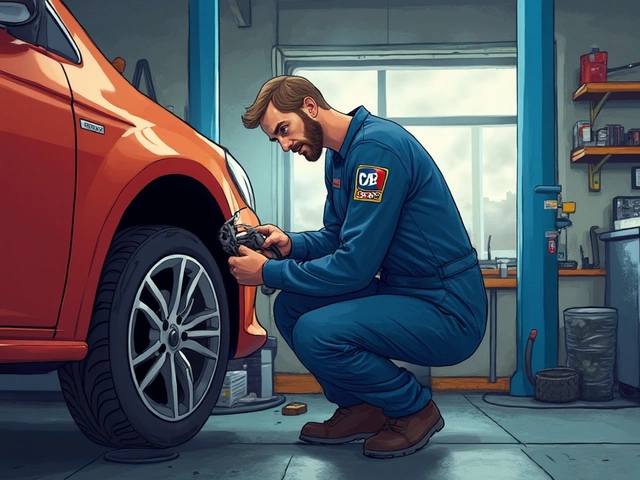Ever try to drive in heavy rain with wipers that just smear water across your windshield? It’s annoying—and honestly, it can get sketchy fast. Wiper blades get overlooked all the time, but they work hard to keep your view clear and your nerves calm when the weather throws you a curveball.
If you haven’t thought about swapping out your wiper blades lately, you’re not alone. Most people wait until they’re practically useless. Thing is, old wipers not only mess with visibility but can even scratch up your windshield if the rubber’s worn down to nothing. Fixing a scratched windshield? Way more expensive and time-consuming than popping on a new set of blades.
Wondering how often you should actually replace them? You’ll get a straightforward answer coming up, plus some handy facts and tricks to make your wipers last longer. Because nobody likes those moments where you realize, at the worst possible time, that your wipers just aren’t cutting it anymore.
- Why Wiper Blades Wear Out
- How Often to Replace Your Wiper Blades
- Signs You Need New Wipers
- Easy Checks and DIY Tips
- Making Your Wipers Last Longer
Why Wiper Blades Wear Out
Wiper blades aren’t built to last forever. The rubber edge has to deal with a ton—sun, rain, dirt, ice, and whatever else the road throws at your windshield. Over time, stuff like UV rays and temperature swings make the rubber stiff, causing it to crack or split. If you leave your car outside, you’ll see your blades wear out quicker than if you park in a garage.
Dirt and sand on the windshield scratch up the blade surface. Every time you use them, tiny particles act like sandpaper on the rubber. That means if you often drive on dusty roads or right after a rainstorm, your wipers are working overtime. Plus, using your wipers on dry glass (a habit people pick up when cleaning dust) actually damages the edge faster.
Winter brings even more headaches. Cold temps make the rubber brittle, and ice or snow stuck to your windshield can really mess up the blades. Some folks forget to pop their wipers up before a snowstorm, and that leads to the rubber freezing to the glass and tearing when you try to use them.
- Hot weather dries out and cracks the rubber.
- Dirt, sand, and bugs chew up the blade edges.
- Snow and ice can glue the blade to the glass or snap it off if you’re not careful.
- Age alone—blades break down sitting around, even if you hardly use them.
Bottom line: all that abuse wears them down until they can’t clear your windscreen wipers properly. You might not notice until you’re hit with a downpour and discover you’re basically driving blind.
How Often to Replace Your Wiper Blades
Most car experts will tell you that wiper blades should be replaced every 6 to 12 months, but the exact timing depends on a bunch of stuff—like weather, how much you drive, and how often you actually use your wipers. If you live somewhere rainy or snowy, expect to change them more often. Somewhere dry and sunny? The sun can still break down the rubber fast, so don’t push your luck.
According to the wiper blades manufacturer Bosch, “Wiper blades should ideally be replaced at least once a year to ensure optimal visibility and performance.”
“Old or damaged wiper blades can reduce driver visibility, especially in extreme weather conditions, leading to a higher risk of accidents.” — AAA Exchange
Check out how the climate plays a role in blade lifespan:
| Climate | Average Replacement Interval |
|---|---|
| Hot/Sunny | Every 6 months |
| Rainy/Coastal | Every 6-9 months |
| Cold/Snowy | Every 6-12 months |
| Mild | Every 12 months |
It’s pretty clear: weather eats away at the rubber, whether it’s sun, salt, or snow. Don’t set a calendar reminder and forget about it, though—watch for wiper performance getting streaky or squeaky. More on spotting those signs later, but staying on schedule helps avoid getting caught in the rain (or snow) with bad blades.
- Heavy city driving? Road grime wears blades faster.
- Highway miles? Bugs and dirt do their part, too.
- Parked outside? UV rays can dry out rubber, even if you don’t drive much.
If you want to play it safe, swap them out at least once a year—maybe twice if you’re in harsh conditions. It’s a cheap fix that pays off every time you need a clear view.

Signs You Need New Wipers
The easiest way to know it’s time for new wiper blades is by checking how they handle water on your windshield. If they miss spots or just push water around, they're probably done. But let’s get a bit more specific, because there are obvious and not-so-obvious signs.
Look out for these classic giveaways:
- Streaks or smears instead of a clean wipe—even after you just cleaned your windshield.
- Squeaking or chattering noises every time you use them. That sound usually means the rubber isn’t making proper contact with your windshield anymore.
- Splitting or cracking on the rubber blade itself. Flex the blade a bit and look closely—if it’s got tears or feels brittle, it’s ready to go in the trash.
- Visible wear on the edge—look for anything jagged or uneven.
- Missed spots: If part of your view stays covered in water, even after a few wipes, the blade isn’t flexing or pressing right.
Guess what? Environmental stuff chews up blades, too. Sun, dirt, salt in the winter, even bug guts and sap can all wear them down.
Here's a quick look at how long typical wiper blades last and common trouble signs:
| Issue | What You See/Feel | Common Lifespan* |
|---|---|---|
| Streaking | Lines left behind, poor visibility | 6-12 months |
| Skipping or Chattering | Judder movement, noise | 6-12 months |
| Splitting/Cracking | Torn, hard, or broken rubber | 12+ months if not changed |
| Missing Coverage | Unwiped spots remain | 6-12 months |
*Most car makers suggest swapping out wiper blades at least once a year, but heavy use or extreme weather can cut that down a lot.
If you spot any of those signs—or just feel like your wipers aren’t doing their job—don’t wait until the next downpour. Fresh blades are cheap insurance for good visibility.
Easy Checks and DIY Tips
You don’t have to be a car expert to keep your wiper blades doing their job. Here are some simple ways to check and care for them before you find out they’re shot during a downpour.
- Windshield wiper blades should lie flat against the glass with no gaps. If they look twisted or the rubber’s coming apart, it’s time for new ones.
- Lift each wiper arm and run your finger along the rubber. If you feel nicks, splits, or the rubber feels stiff, swap them out. Good blades stay flexible, even in cold or hot weather.
- During a wash, spray the windshield and turn on the wipers. Streaks, squeaks, or skipped spots are signs of worn blades (or sometimes just a dirty windshield).
- Clean the blades once a month with a damp cloth and regular dish soap. Dirt build-up shortens their life big time.
- If they struggle with heavier rain, start chattering, or leave foggy lines, don’t wait around—they’re past their prime.
Most wiper blade brands suggest replacing them every 6 to 12 months, but if you live in a place with hot summers or harsh winters, check more often. UV rays, road grime, and even pollen wear them out quicker.
| Condition | Action Needed |
|---|---|
| Blades are streaking or squeaking | Clean or replace |
| Rubber is cracked, split, or missing chunks | Replace |
| Blades make chattering noise | Check for dirt, try cleaning; if noise stays, replace |
| Metal frame is bent | Replace entire assembly |
| Wipers miss spots during swipes | Replace |
Replacing wiper blades yourself is usually easy. Here’s how:
- Buy the right size—don’t guess. Measure your old blades or check your car’s manual.
- Lift the wiper arm—careful, the spring can snap back fast.
- Press the small tab where blade meets arm, then slide blade off.
- Snap the new blade in place. It should click.
- Gently set the arm back down. Test with washer fluid to make sure you nailed it.
Spend five minutes a month on these checks, and you’ll never be stuck driving blind when the weather turns nasty.

Making Your Wipers Last Longer
You don’t have to treat wiper blades as a disposable afterthought. A little care goes a long way and can actually save you cash. Here are easy ways to keep your wipers working better for longer.
- Clean Your Blades Regularly: Dirt, bug guts, and pollen build up fast. Each week, take a damp cloth and gently wipe the rubber edge of each blade. This gets rid of gunk that can shred them faster than you’d think.
- Keep the Windshield Clean: If your windshield is grimy, your wipers have to work harder—and dirt acts like sandpaper. Spend a minute at the gas station to squeegee that glass free of debris.
- Lift Wipers in Extreme Weather: When you know snow or ice is coming, pull your wipers up so they don’t freeze to the glass overnight. Scraping them loose can tear the rubber right off.
- Don’t Run Wipers on Dry Glass: It’s tempting to clear dust or pollen with a quick swipe, but dry running rubs the blades raw. If you must, hit the washer fluid first.
- Check for Damage After Each Season: Hot summers and freezing winters both punish wiper blades. At the end of each season, give them a quick look for cracking or warping.
How much difference does this stuff actually make? Here’s a look at how common habits affect typical wiper blade life spans:
| Habit | Average Blade Lifespan |
|---|---|
| Regular cleaning & proper care | 12 months |
| No maintenance / exposed to hot sun | 6 months or less |
| Frequent scraping off ice | 3-6 months |
It’s a small time investment for way better visibility—plus you avoid those first tiny streaks that show your wipers are headed for early retirement. Double check them especially before a road trip, or when storms are in the forecast. Your future self will thank you.


